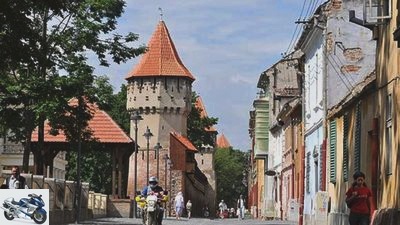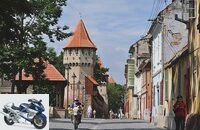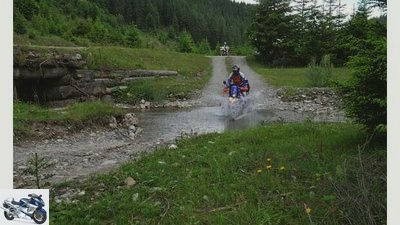Table of contents

Streblow
to travel
Out and about in Romania
Out and about in Romania
New truths
Forty years after the author and his parents were on the road in Romania at the invitation of the local writers’ association, he set off again. And drove through a dramatically changed country.
Nicolas Streblow
December 04, 2008
Our first trip took place in a different time, in a different country. At least politically. In 1968 Romania was shaped by liberal communism, similar to the Czech Republic. But that should change shortly after our tour, which I hardly remember because of my tender age. Nicolae Ceauşescu, the criminal dictator, plunged the country into the abyss, sucked its people up to the point of blood. Everyday life was dominated by poverty, reprisals and disappointments. After the fall of the Ceauşescu regime in December 1989, there was nothing left of Romania in my father’s stories, a country full of friendly people in a spirit of optimism. Only where socialism was barely enough, far from the capital Bucharest, was the population able to maintain their traditional way of life.
Almost two decades later, Romania is still in a state of upheaval. Young people in particular are migrating to western countries to earn money, but membership of the EU since January 1, 2007 not only creates new temples for consumption, but also makes people realize that initiative and work are paying off in their own country. One of the opportunities is called tourism. That’s another reason we’re here, Marco, Andrea and I, but not only. We are attracted by traces of the past, adventure, curiosity.
We took the DB Autozug to Vienna, from there on our motorbikes quickly through Hungary and across the border at the westernmost tip of Romania near Arad. Formalities are no longer applicable since EU membership, the vignette for the general road toll is not needed on a motorcycle. We follow the border with Serbia to switch to the route taken 40 years ago. It should go to Timişoara, then via Reşita along the Carpathian Mountains to the east. “The road almost always divides into two separate lanes as soon as you enter the town. In between, wide flower beds, rose beds. Every place has its Strada Trandafirilor, its street of roses. ”My father noted this in his travel report.
We don’t see any roses, the colorfulness described back then no longer exists. The roads, on the other hand, seem unchanged and are still used by horse-drawn vehicles. Young people are also on the go with it, connected to today via the cell phone on their ear. The blessings of this “today” encounter one on the way from the villages to the university city of Timişoara. First in the form of an overflowing garbage dump, then along the access roads with the usual hardware store and snack bars. In the city center, however, the charm from the K.u.K. times, crumbling, but with atmosphere. Victory Square with a view of the Orthodox Cathedral is well worth a detour. Likewise the dangling through the Banat Mountains.
Buy complete article

Out and about in Romania
New truths
8 pages) as PDF
€ 2.00
Buy now

Streblow
A very careful driving style is required on Romanian roads because you share the roads with pedestrians, cyclists, horse-drawn carts and motorists.
Between the industrial town of Reşita and Anina with the ruins of an oil shale power plant, a fantastic motorcycle road winds through the mountain landscape, which looks like a mixture of the Apennines and Allgau. No less attractive: the continuation of the route along the Danube. In the health resort of Herkulesbad, the visible consequences of decades of mismanagement: a hotel high-rise is just as decaying as the Wilhelminian style villas. Because the road at the Cerna Reservoir is impassable after a landslide, only the heavily trafficked main road 6 remains to get to Caransebeş. Only the curvy slope between Hateg and Hunedoara is balm for our senses again.
“Compared to Western European conditions, road traffic is extremely relaxing,” my father noted elsewhere in his report. There really is no longer any question of that. We quickly gave up the original idea of following the old route, because the main roads nowadays cause miserable annoyance due to the chaotic traffic. The little-traveled back roads, which can be found in all states of preservation, are more fun in every respect. We roll on them from Sebeş via Sugag to the almost 1700 meter high Tartarau. Although it is barely noticeable as a pass, the route is a splendid landscape. It’s a shame that the subsequent Urdele Pass is closed. Forest workers compensate us for the blocked journey with an invitation to dinner. There is a spicy meat dish called Mititei, pronounced Mitsch, from the charcoal grill.
We don’t want to miss Sibiu, so we head for the hills south of Hermannstadt, which is well-stocked with guesthouses, as Sibiu is called in German. “Sibiu shows a medieval cityscape, interwoven with modern accents.” Fortunately, nothing has changed in that regard, the center of the Transylvanian capital escaped even the demolition craze of the Ceauşescu era. Thanks to the Transylvanian Saxony branch in the 12th century, German is omnipresent here. There is a German weekly newspaper, German schools and bilingual street signs.
Even more multicultural: Sighişoara, also known as Schabburg. In addition to Romanian and German, Hungarian is spoken here. The castle, visible from afar, and the clock tower as a landmark are just as worth seeing as the rest of the old center. Teams of horses are locked out at the entrance to the village, motorbikes are allowed to pass.
Pojana Braşov, the summer resort belonging to Kronstadt at an altitude of 1000 meters, was already a tourist resort with many hotels 40 years ago. To date there have been a few more. We can’t help but take a detour to the nearby Bran Castle, knowing full well that the brutal example of the Dracula novels never lived there. Regardless, the myth brings foreign exchange. The trip to Buzau turns out to be more exciting. The Carpathian roads are a pleasure to drive. On the way to Valenii it becomes more and more lonely, the villages appear poorer, and in the eastern foothills we reach the only mud volcanoes on mainland Europe. A fascinating, lunar landscape bubbling away.

Streblow
Ford at the Damuc Pass.
Our feet are up to our ankles in the water, the traffic light at the intersection in Tulcea is red. It is pouring as if the Danube Delta was about to be flooded. Fortunately, our boat for the excursion through the largest reed area on earth has a roof, but unfortunately it is too fast. We don’t notice much of the species-rich fauna, but we see a lot of the natural landscape on the Black Sea.
When we get back on our motorcycles the next morning, the sky is as if polished. In the absence of bridges over the Danube, a jam-packed ferry takes you to Galati. Loneliness reigns along road number 26 to Bârlad. The hilly landscape around Adjud is almost uncanny, no mast, no line disturbs the view. We are alone with the evening light, fantastically beautiful.
We reach Bukovina, an area also known as “the Vltava”, on a Sunday. Nevertheless, the shops are open, construction workers are active, while hosts of people in Sunday attire populate the streets. A gravel road branches off to the Bicaz Gorge and Lake Rosu. We pass the highest rock walls in Romania. In the elongated villages it is noticeable that there is almost no decay, everything looks friendly and well-kept. Incredible road damage makes the drive over the Petru Vodaˇ pass an adventure, we are happy about the long suspension travel of our enduros.
“The Middle Ages and the modern grow side by side, there are hardly any transitions. Every time we drive through older neighborhoods from the prewar period, our interpreter says: This will be torn down, everything will be new. ”In Piatra Neamt, this has largely happened, only the buildings around the central Freiheitsplatz have been preserved. Towards the Ukrainian border are the Vltava monasteries, famous for their colorful frescoes. Because the churches were too small for the people pouring in, the Bible motifs were applied to the outside of the church. A pleasant area. The Tarnita Pass, on the other hand, is strange: unlike comparable stretches of this category, the road is concreted throughout. The solution to the riddle can be found on the north side: an extensive mine complex, long abandoned to decay and the perfect end-of-time backdrop. What was under construction in 1968 now only spoils the landscape.
“If it weren’t for telephone wires and television antennas, modern tractors and machines in the fields, you would feel like you’re on a trip into the past.” They are now satellite dishes, but people work in the fields because there is not enough money for new machines. The forest railway in the Wassertal near Vişeu de Sus appears similarly archaic. Without the narrow-gauge railway, people cannot get the wood out of the mountains. The ride is a real adventure: right along the river, rocking, stomping and sometimes derailing.
The Maramures in the northwest are the most pristine area of Romania, nothing has changed here in the small private businesses; the people don’t care who does nothing for them in Bucharest. The little road from Vişeu de Jos to Bogdan Voda offers a nice farewell view of the landscape, and at the border behind Satu Mare a sign says “Drum Bun” – good way.
Info
Romania shows contrasts between yesterday and today. You will witness how people shed socialism and realign their beautiful country. An exciting tour.
Travel time: 14 days. Distance covered: 2000 kilometers
getting there
The long journey is shortened by the car train to Vienna, which is booked through OBB. Trains run from Berlin, Hamburg and Dusseldorf to Vienna, more information at www.dbautozug.de, button travel destinations. After entering the destination “Vienna” you will be forwarded. The trip through Hungary can then be done in one day if necessary. Coming from southern Germany via Croatia and Serbia is an alternative.
Travel time
May may be too early for the Carpathians, and July too hot for the Dobruja Plain. June can work, but it can be rainy at times. August should also be avoided in Romania, so September remains the ideal month.
traffic
The recommendation for Romania is clearly touring enduro, preferably with studded tires. Otherwise the driving fun may be over at the first mud hole. It is advisable to drive extremely cautiously on Romanian roads because you share the roads with pedestrians, cyclists, horse-drawn vehicles and motorists. The latter drive recklessly and ignore traffic rules. Main roads should be avoided. Driving on back roads is a real pleasure, but it is possible that routes prove to be impassable or do not correspond to the category shown in the map material.
insurance
Romania has recently joined the EU, but it is still advisable to take out private accident insurance and, for expensive machines, fully comprehensive insurance. The risk of colliding with a road user who is not insured is higher than in other EU countries. Even if you get into contact with an insured party involved in the accident, the amounts insured are far too low.
accommodation
In tourist areas there is usually a good selection of accommodation in all price ranges. Hotels from socialist times can often be found in larger cities. On average, the hostels cost half the German standard. We recommend the Villa Crizantema in Moldovita (www.vilacrizantema.ro) or the guesthouse of Vasile Barsan in Vi? Eu de Sus on the Wassertalbahn (phone 0040 / (0) 262/355653). Campsites are rather rare.
literature
Culture shock Romania, travel know-how (14.90 euros), Romania really travel, Dumont (22.95 euros). Map by Marco Polo, 1: 650,000 (8.50 euros), Atlas by Freytag and Bernt, 1: 250,000 (19.95 euros). Internet: www.romania-tourism.
Organized tour
If you don’t want to explore Romania on your own, you can go on a voyage of discovery with the MOTORRAD action team in July and August 2009. More information: Telephone 0711 / 182-1977 or www.actionteam.de.
Related articles
-
to travel Endurotip Romania Endurotip Romania Enduromania No driving bans, no road closures, demanding slopes – with these arguments, EnduRoMania…
-
Traveling by motorcycle in Romania
Deleker 15th pictures Deleker 1/15 Traveling by motorcycle in Romania. Beautiful streets, villages and very friendly people make the trip an experience….
-
Nennewitz to travel KTM and Husqvarna in Romania KTM and Husqvarna in Romania Enduro tour in the Carpathian Mountains What is life like in a country of…
-
New forest law in Romania: No more limitless enduro fun
Rossen Gargolov counselor traffic & business New forest law in Romania: No more limitless enduro fun New forest law in Romania No more limitless enduro…
-
Fisherman to travel Romania Romania In all silence It’s calm and relaxed between the Carpathian Mountains and the Black Sea coast. Dracula’s home…
-
to travel Nepal Nepal Once limit value and back With a 500 Enfield to the eight-thousanders on earth. A journey between wooden sheds and pagoda temples…
-
Daams to travel Montenegro Montenegro Phoenix from the ashes The southernmost fjord, the deepest canyon and one of the last primeval forests in Europe ??…
-
Lorenz to travel Poland and the Baltic States Poland and the Baltic States Stars in the east Estonia, Latvia and Lithuania: Completely different in…
-
to travel Vietnam Vietnam In the middle Lively chaos is nothing new in Southeast Asia – to experience it in Vietnam, on the other hand, is. After two…
-
blade to travel Ukraine Ukraine It has to be caviar The plan to spend our next vacation in Ukraine met with a lot of incomprehension. Why go there and…